Strategies Regarding High-Temperature Applications w.r.t Strength, Toughness, and Fatigue Life for SA508 Alloy
Abstract
:1. Introduction
1.1. Background
1.2. Computational Specifications
2. Secondary Phases (G-Phase, Cementite, Carbides, and Inclusions) Effects on Mechanical Properties of SA508 Steel
3. Results and Discussions
3.1. Phase Transformations
3.2. Effect of Carbon
3.3. Effect of Manganese
3.4. Effect of Silicon
3.5. Mechanical Properties
4. Proposed Composition Regarding High Toughness and Fatigue Properties at 650 K
5. Conclusions
Supplementary Materials
Author Contributions
Funding
Institutional Review Board Statement
Informed Consent Statement
Data Availability Statement
Acknowledgments
Conflicts of Interest
References
- Ahn, Y.S.; Kim, H.D.; Byun, T.S.; Oh, Y.J.; Kim, G.M.; Hong, J.H. Application of intercritical heat treatment to improve toughness of SA508 Cl.3 reactor pressure vessel steel. Nucl. Eng. Des. 1999, 194, 161–177. [Google Scholar] [CrossRef]
- Klueh, R.L.; Nelson, A.T. Ferritic/martensitic steels for next-generation reactors. J. Nucl. Mater. 2007, 371, 37–52. [Google Scholar] [CrossRef]
- Gao, Q.; Liu, Y.; Di, X.; Yu, L.; Yan, Z.; Qiao, Z. Influence of austenitization temperature on phase transformation features of modified high Cr ferritic heat-resistant steel. Nucl. Eng. Des. 2013, 256, 148–152. [Google Scholar] [CrossRef]
- Li, J.; Zhang, C.; Jiang, B.; Zhou, L.; Liu, Y. Effect of large-size M23C6-type carbides on the low-temperature toughness of martensitic heat-resistant steels. J. Alloys Compd. 2016, 685, 248–257. [Google Scholar] [CrossRef]
- Sun, J.; Zhang, Y.; Wang, P.; Ye, Z.; Li, D. Effect of N on the microstructure and mechanical properties of high si martensitic heat-resistant steels. Acta Metall. Sin. (Engl. Lett.) 2014, 27, 573–584. [Google Scholar] [CrossRef]
- Nam, W.J.; Choi, H.C. Effects of silicon, nickel, and vanadium on impact toughness in spring steels. Mater. Sci. Technol. 1997, 13, 568–574. [Google Scholar] [CrossRef]
- Douglass, D.L.; Armijo, J.S. The effect of silicon and manganese on the oxidation mechanism of Ni-20 Cr. Oxid. Met. 1970, 2, 207–231. [Google Scholar] [CrossRef]
- Cha, S.C.; Hong, S.H.; Kim, M.Y.; Park, J.; Shim, J.H.; Jung, W.S.; Rath, M.; Kozeschnik, E. CALPHAD-based alloy design for advanced automotive steels—Part II: Compositional and microstructural modification for advanced carburizing steels. Calphad Comput. Coupling Phase Diagrams Thermochem. 2016, 54, 172–180. [Google Scholar] [CrossRef]
- Lo, K.H.; Shek, C.H.; Lai, J.K.L. Recent developments in stainless steels. Mater. Sci. Eng. R Rep. 2009, 65, 39–104. [Google Scholar] [CrossRef]
- Tan, L.; Katoh, Y.; Rowcliffe, A.F.; Garrison, L.M.; Yamamoto, Y. Materials challenges for the fusion nuclear science facility. Fusion Eng. Des. 2017, 135, 290–301. [Google Scholar] [CrossRef]
- Stichel, W. Handbook of comparitative world steel standards; USA-United Kingdom-Germany-France-Russia-Japan-Canada-Australia-International. Hrsg.: Albert & Melilli, 552 Seiten. ASTM Data Series DS 67, American Society for Testing and Materials, PA, USA 1996, ISBN 0-8031-1825-2. Mater. Corros. 1997, 48, 399. [Google Scholar] [CrossRef]
- Hu, X.; Wang, J.; Wang, Y.; Li, J.; Wang, Z.; Dang, Y.; Gu, Y. Two-way design of alloys for advanced ultra supercritical plants based on machine learning. Comput. Mater. Sci. 2018, 155, 331–339. [Google Scholar] [CrossRef]
- Chen, H.L.; Mao, H.; Chen, Q. Database development and Calphad calculations for high entropy alloys: Challenges, strategies, and tips. Mater. Chem. Phys. 2018, 210, 279–290. [Google Scholar] [CrossRef]
- Saunders, N.; Guo, Z.; Li, X.; Miodownik, A.P.; Schillé, J.P. Using JMatPro to model materials properties and behavior. JOM 2003, 55, 60–65. [Google Scholar] [CrossRef]
- Ebrahimi, G.R.; Momeni, A.; Ezatpour, H.R. Modeling the viscoplastic behavior and grain size in a hot worked Nb-bearing high-Mn steel. Mater. Sci. Eng. A 2018. [Google Scholar] [CrossRef]
- Smith, A.; Asadikiya, M.; Yang, M.; Chen, J.; Zhong, Y. An Investigation of Creep Resistance in Grade 91 Steel through Computational Thermodynamics. Engineering 2020, 6, 644–652. [Google Scholar] [CrossRef]
- Hasan, S.M.; Ghosh, M.; Chakrabarti, D.; Singh, S.B. Development of continuously cooled low-carbon, low-alloy, high strength carbide-free bainitic rail steels. Mater. Sci. Eng. A 2020, 771, 138590. [Google Scholar] [CrossRef]
- Zheng, Y.; Wang, F.; Li, C.; Li, Y.; Cheng, J. Microstructural evolution, coarsening behavior of precipitates and mechanical properties of boron bearing steel 25CrMoNbB during tempering. Mater. Sci. Eng. A 2018, 712, 453–465. [Google Scholar] [CrossRef]
- Wang, Y.Q.; Han, J.; Wu, H.C.; Yang, B.; Wang, X.T. Effect of sigma phase precipitation on the mechanical and wear properties of Z3CN20.09M cast duplex stainless steel. Nucl. Eng. Des. 2013, 259, 1–7. [Google Scholar] [CrossRef]
- Lin, S.-G.; Yang, H.-H.; Su, Y.-H.; Chang, K.-L.; Yang, C.-H.; Lin, S.-K. CALPHAD-assisted morphology control of manganese sulfide inclusions in free-cutting steels. J. Alloys Compd. 2019, 779. [Google Scholar] [CrossRef]
- Bhadeshia, H.K.D.H.; Edmonds, D.V. Bainite in silicon steels: New composition-property approach. Met. Sci. 1983, 17, 420–425. [Google Scholar] [CrossRef]
- Nazemi, F.; Hamel-Akré, J.; Bocher, P. Modeling of cementite coarsening during tempering of low-alloyed-medium carbon steel. J. Mater. Sci. 2018, 53, 6198–6218. [Google Scholar] [CrossRef]
- Takeuchi, T.; Kameda, J.; Nagai, Y.; Toyama, T.; Matsukawa, Y.; Nishiyama, Y.; Onizawa, K. Microstructural changes of a thermally aged stainless steel submerged arc weld overlay cladding of nuclear reactor pressure vessels. J. Nucl. Mater. 2012, 425, 60–64. [Google Scholar] [CrossRef]
- Schäfer, L. Influence of delta ferrite and dendritic carbides on the impact and tensile properties of a martensitic chromium steel. J. Nucl. Mater. 1998, 258–263, 1336–1339. [Google Scholar] [CrossRef]
- Hajra, R.N.; Rai, A.K.; Tripathy, H.P.; Raju, S.; Saroja, S. Influence of tungsten on transformation characteristics in P92 ferritic–martensitic steel. J. Alloys Compd. 2016, 689, 829–836. [Google Scholar] [CrossRef]
- Cha, S.C.; Hong, S.H.; Kim, I.; Kim, M.Y.; Park, J.; Suh, J.Y.; Shim, J.H.; Jung, W.S. CALPHAD-based alloy design for advanced automotive steels—Part I: Development of bearing steels with enhanced strength and optimized microstructure. Calphad Comput. Coupling Phase Diagrams Thermochem. 2016, 54, 165–171. [Google Scholar] [CrossRef]
- Smith, A.; Asadikiya, M.; Chen, J.; Zhong, Y. The compositional optimization and secondary phases evaluation regarding the creep resistance in Grade 91 steel through the CALPHAD approach. Comput. Mater. Sci. 2020, 177, 109591. [Google Scholar] [CrossRef]
- Patra, A.K.; Athreya, C.N.; Mandal, S.; Kumar, K.C.H.; Sarma, V.S. High strength-high ductility medium Mn steel obtained through CALPHAD based alloy design and thermomechanical processing. Mater. Sci. Eng. A 2021, 140756. [Google Scholar] [CrossRef]
- Chen, Q.Y.; Chen, J.; Ren, J.K.; Wang, Z.H.; Liu, Z.Y. Effect of Si content on microstructure and cryogenic toughness of heat affected zone of low nickel steel. Mater. Sci. Eng. A. 2020, 771, 138621. [Google Scholar] [CrossRef]
- Wu, Y.X.; Sun, W.W.; Gao, X.; Styles, M.J.; Arlazarov, A.; Hutchinson, C.R. The effect of alloying elements on cementite coarsening during martensite tempering. Acta Mater. 2020. [Google Scholar] [CrossRef]
- Suh, D.W.; Kim, N.J. Low-density steels. Scr. Mater. 2013, 68, 337–338. [Google Scholar] [CrossRef]
- Pashangeh, S.; Somani, M.C.; Banadkouki, S.S.G.; Zarchi, H.R.K.; Kaikkonen, P.; Porter, D.A. On the decomposition of austenite in a high-silicon medium-carbon steel during quenching and isothermal holding above and below the Ms temperature. Mater. Charact. 2020, 162, 110224. [Google Scholar] [CrossRef]
- Lee, K.H.; Suh, J.Y.; Huh, J.Y.; Park, D.B.; Hong, S.M.; Shim, J.H.; Jung, W.S. Effect of Nb and Cu on the high temperature creep properties of a high Mn-N austenitic stainless steel. Mater. Charact. 2013, 83, 49–57. [Google Scholar] [CrossRef]
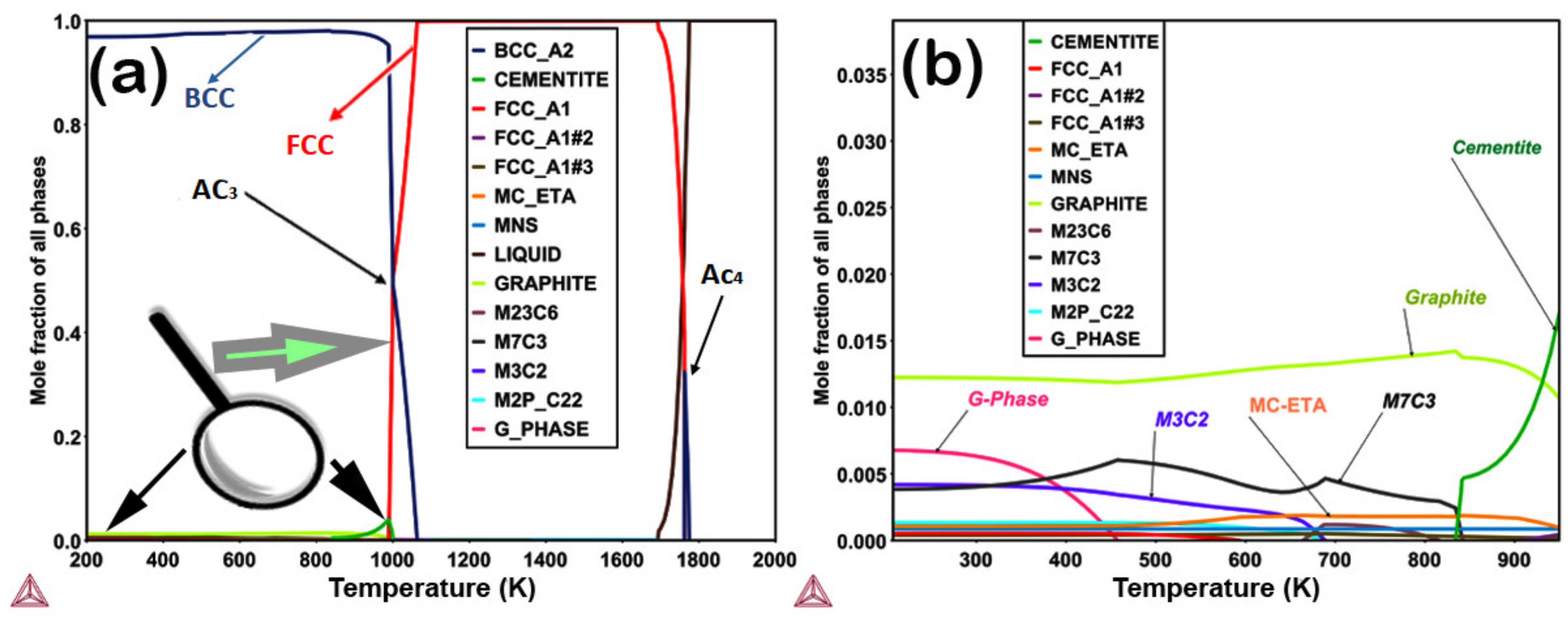
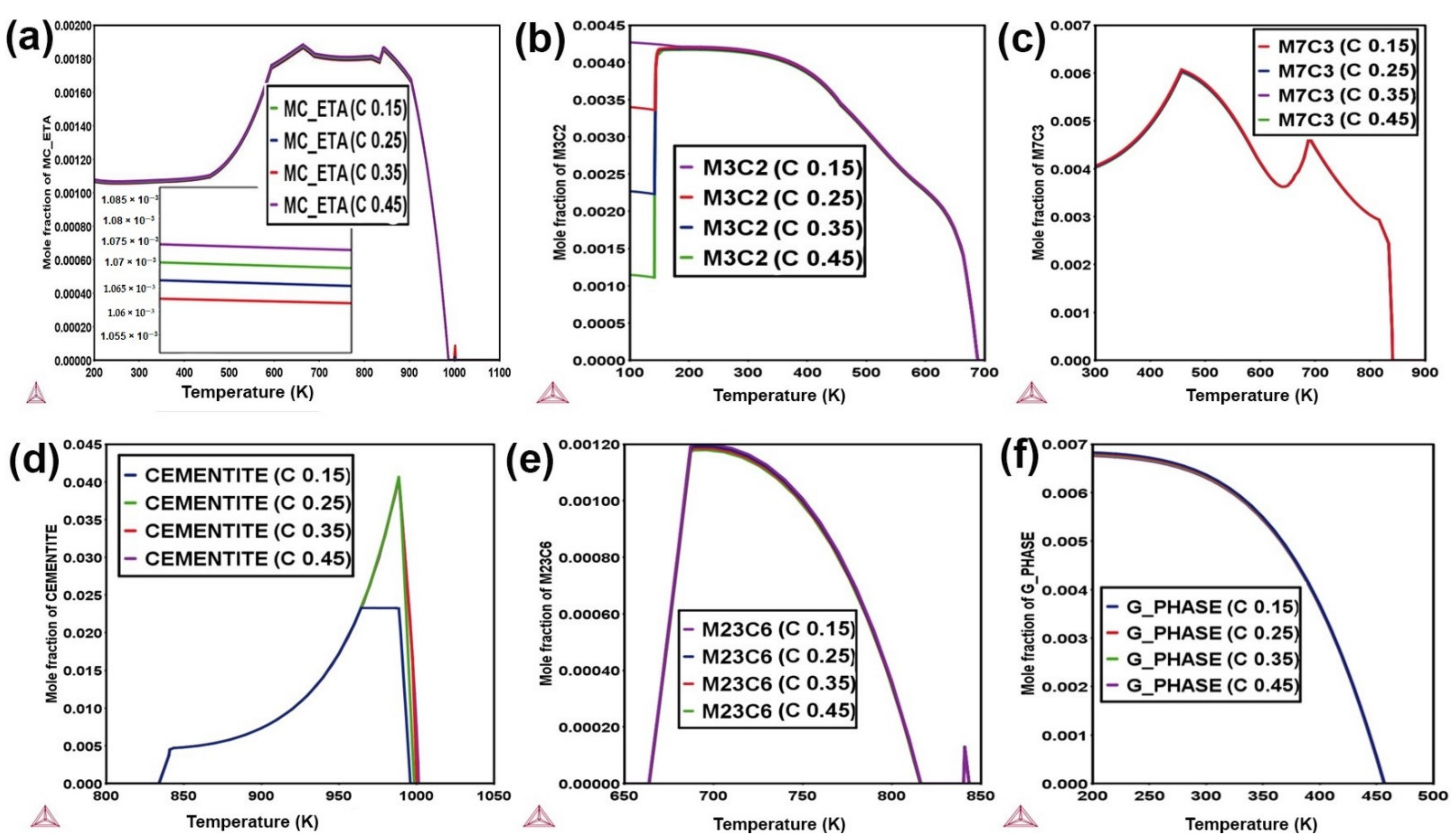
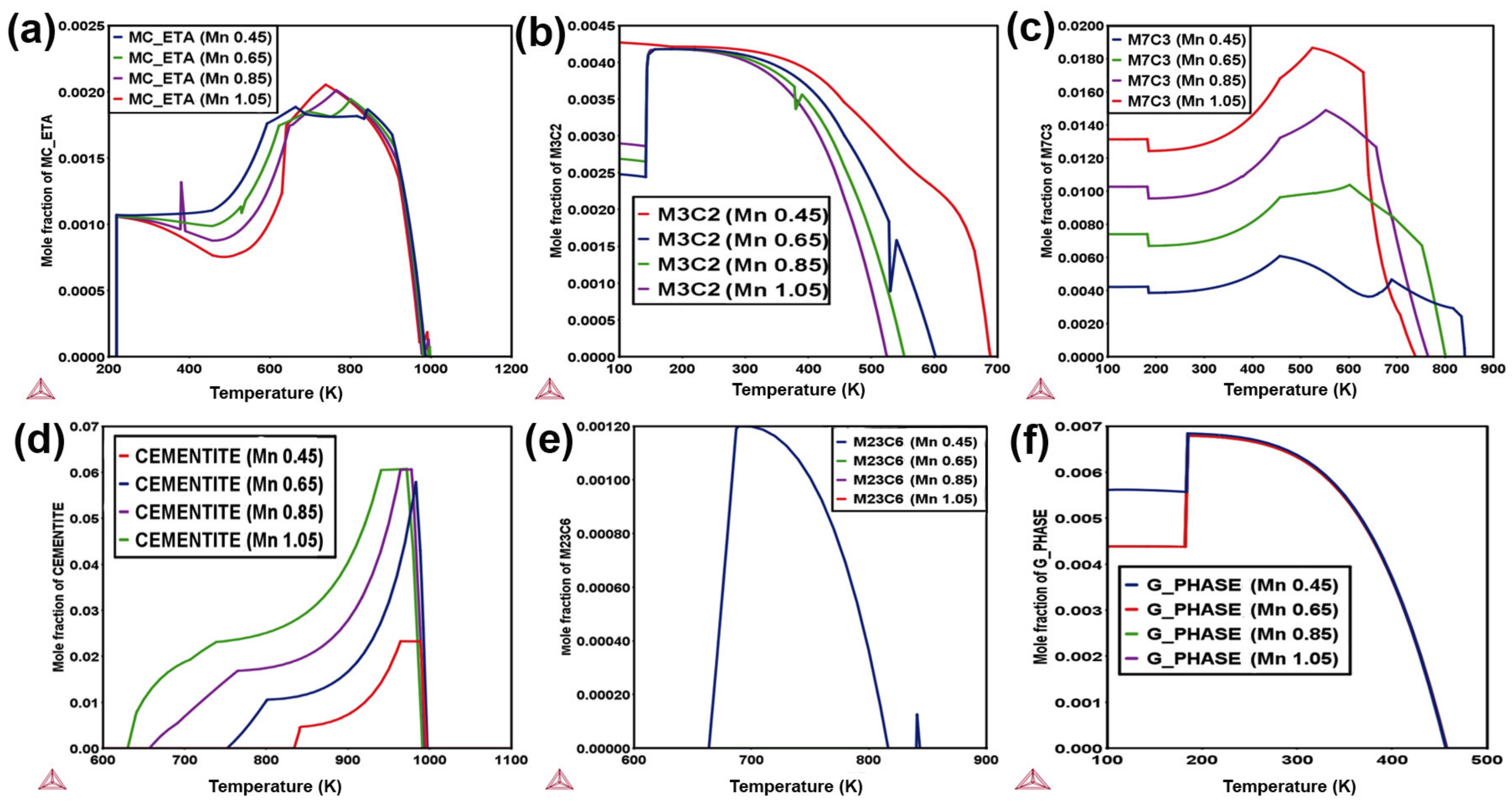
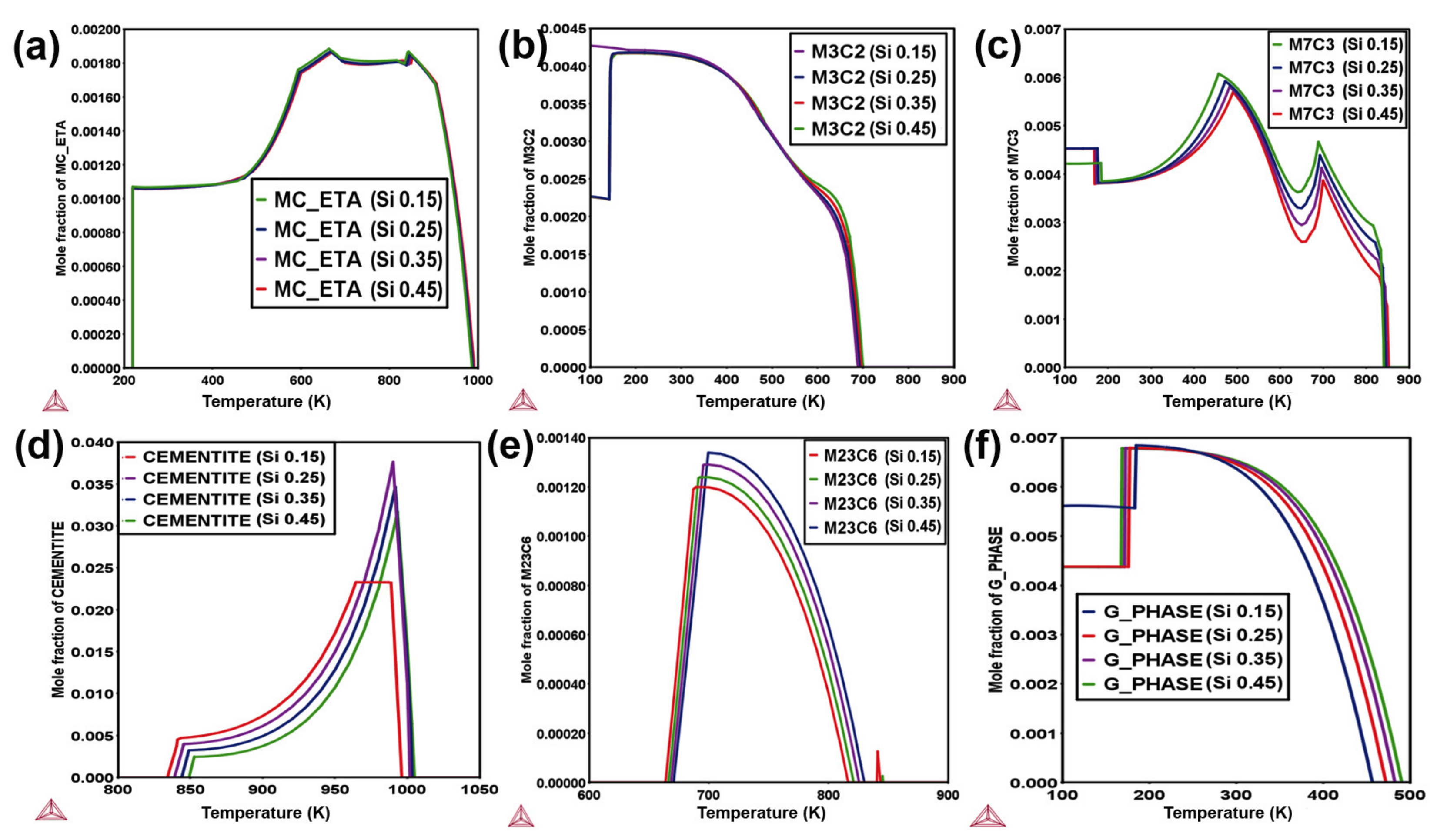

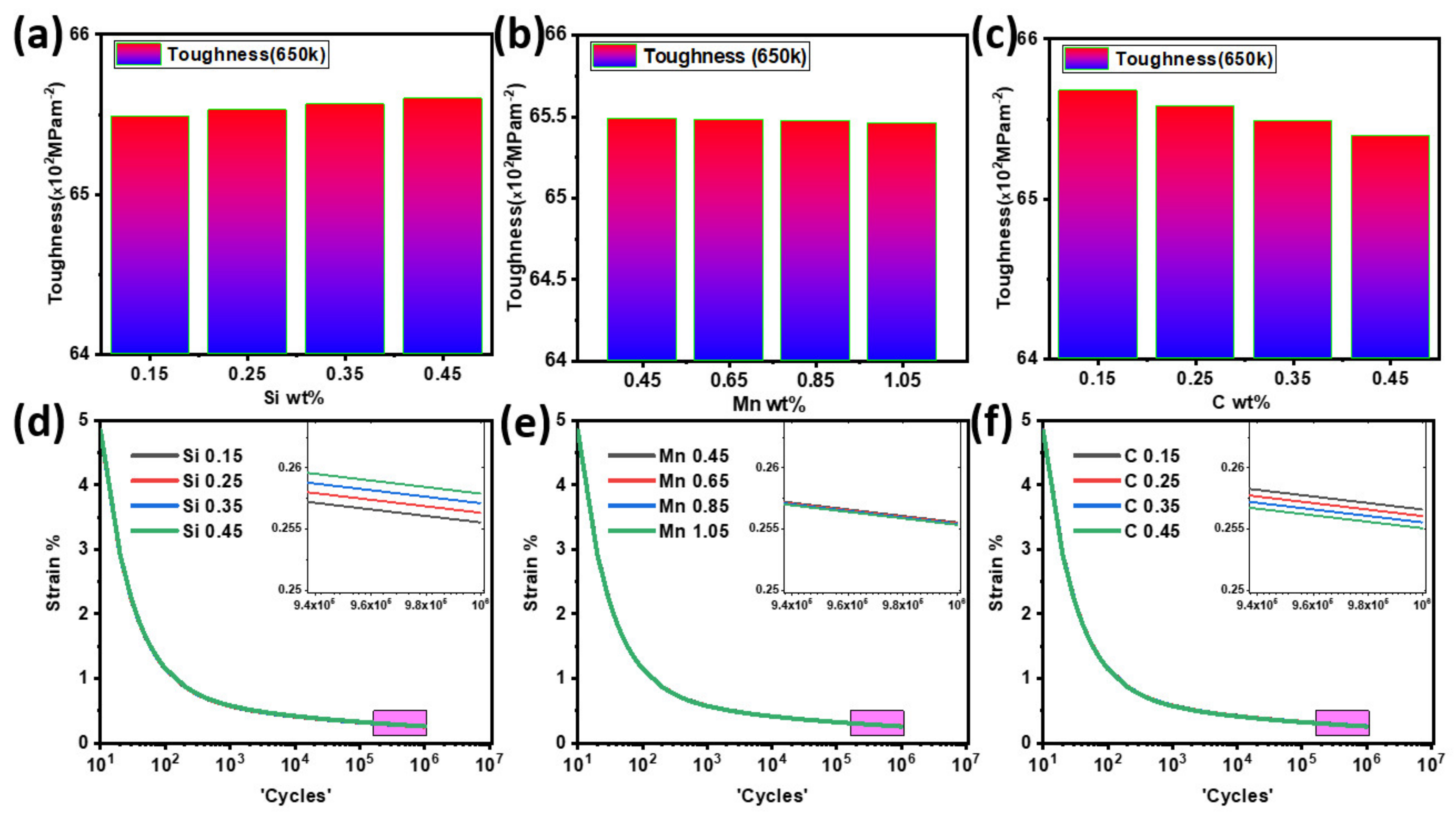
| SA508 Gr1 | C | Mn | P | S | Si | Ni | Cr | Mo | V | Nb | Fe |
|---|---|---|---|---|---|---|---|---|---|---|---|
| ASTM Standard | 0.15–0.45 | 0.45–1.05 | 0.025 | 0.025 | 0.15–0.45 | 0.40 | 0.25 | 0.10 | 0.05 | 0.01 | Bal |
| Reference Sample (RF) | 0.35 | 0.45 | 0.025 | 0.025 | 0.15 | 0.40 | 0.25 | 0.10 | 0.05 | 0.01 | Bal |
| MS1 (Modified Sample C) | 0.15–0.45 | 0.45 | 0.025 | 0.025 | 0.15 | 0.40 | 0.25 | 0.10 | 0.05 | 0.01 | Bal |
| MS2 (Modified Sample Mn) | 0.35 | 0.45–1.05 | 0.025 | 0.025 | 0.15 | 0.40 | 0.25 | 0.10 | 0.05 | 0.01 | Bal |
| MS3 (Modified Sample Si) | 0.35 | 0.45 | 0.025 | 0.025 | 0.15–0.45 | 0.40 | 0.25 | 0.10 | 0.05 | 0.01 | Bal |
| Alloy | C | Mn | P | S | Si | Ni | Cr | Mo | V | Nb | Fe |
|---|---|---|---|---|---|---|---|---|---|---|---|
| Modified Sample | 0.15 | 0.65 | 0.025 | 0.025 | 0.45 | 0.40 | 0.25 | 0.10 | 0.05 | 0.01 | Bal |
| ASTM Standard | 0.15–0.45 | 0.45–1.05 | 0.025 | 0.025 | 0.15–0.45 | 0.40 | 0.25 | 0.10 | 0.05 | 0.01 | Bal |
Publisher’s Note: MDPI stays neutral with regard to jurisdictional claims in published maps and institutional affiliations. |
© 2021 by the authors. Licensee MDPI, Basel, Switzerland. This article is an open access article distributed under the terms and conditions of the Creative Commons Attribution (CC BY) license (https://creativecommons.org/licenses/by/4.0/).
Share and Cite
Abdullah, M.R.; Hongneng, C.; Liang, F. Strategies Regarding High-Temperature Applications w.r.t Strength, Toughness, and Fatigue Life for SA508 Alloy. Materials 2021, 14, 1953. https://doi.org/10.3390/ma14081953
Abdullah MR, Hongneng C, Liang F. Strategies Regarding High-Temperature Applications w.r.t Strength, Toughness, and Fatigue Life for SA508 Alloy. Materials. 2021; 14(8):1953. https://doi.org/10.3390/ma14081953
Chicago/Turabian StyleAbdullah, Muhammad Raies, Cai Hongneng, and Fang Liang. 2021. "Strategies Regarding High-Temperature Applications w.r.t Strength, Toughness, and Fatigue Life for SA508 Alloy" Materials 14, no. 8: 1953. https://doi.org/10.3390/ma14081953







